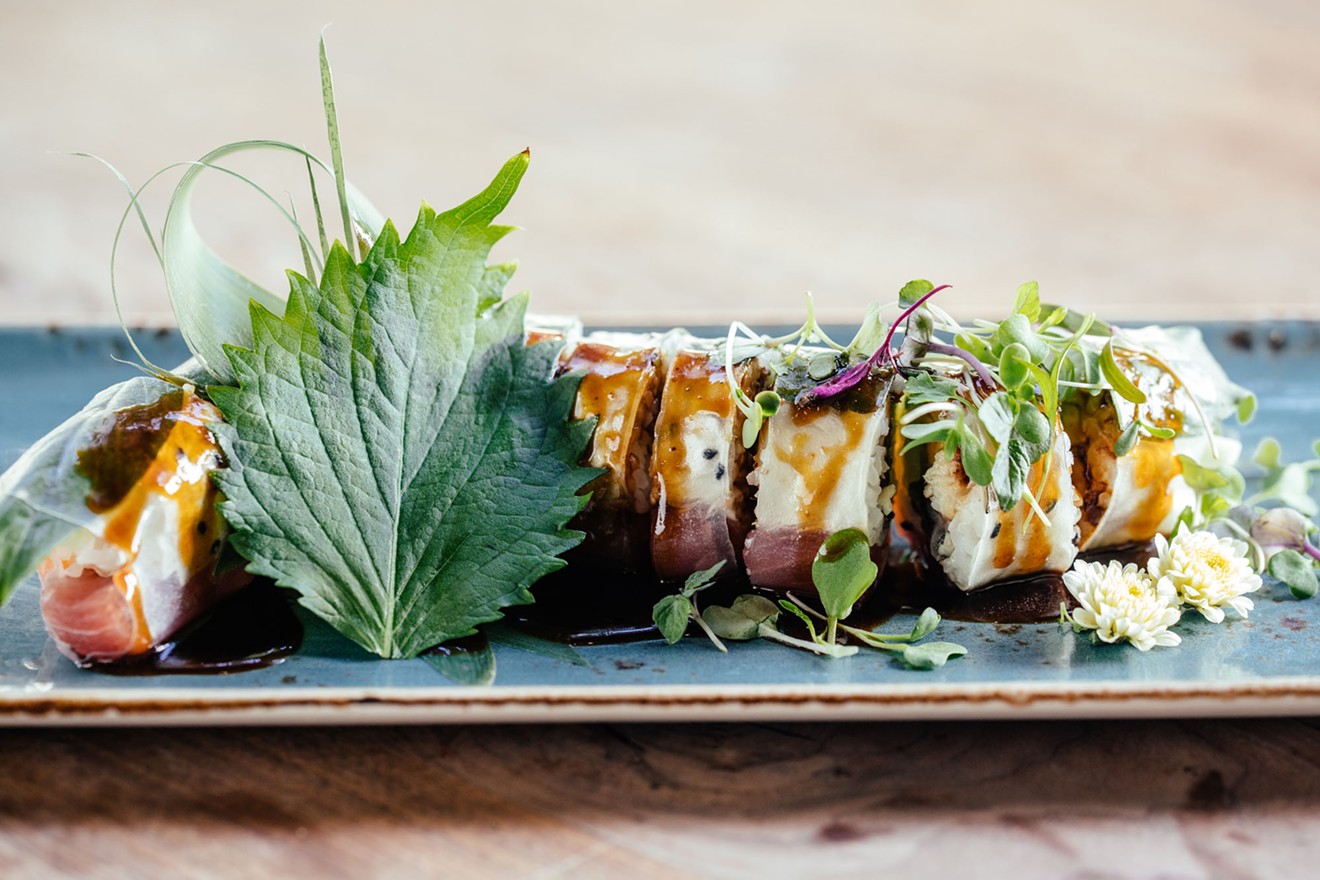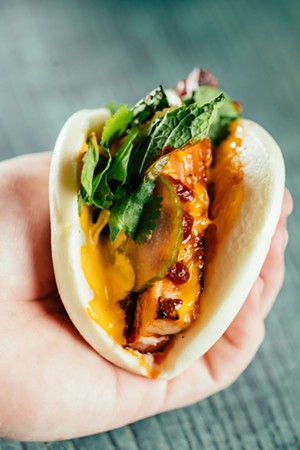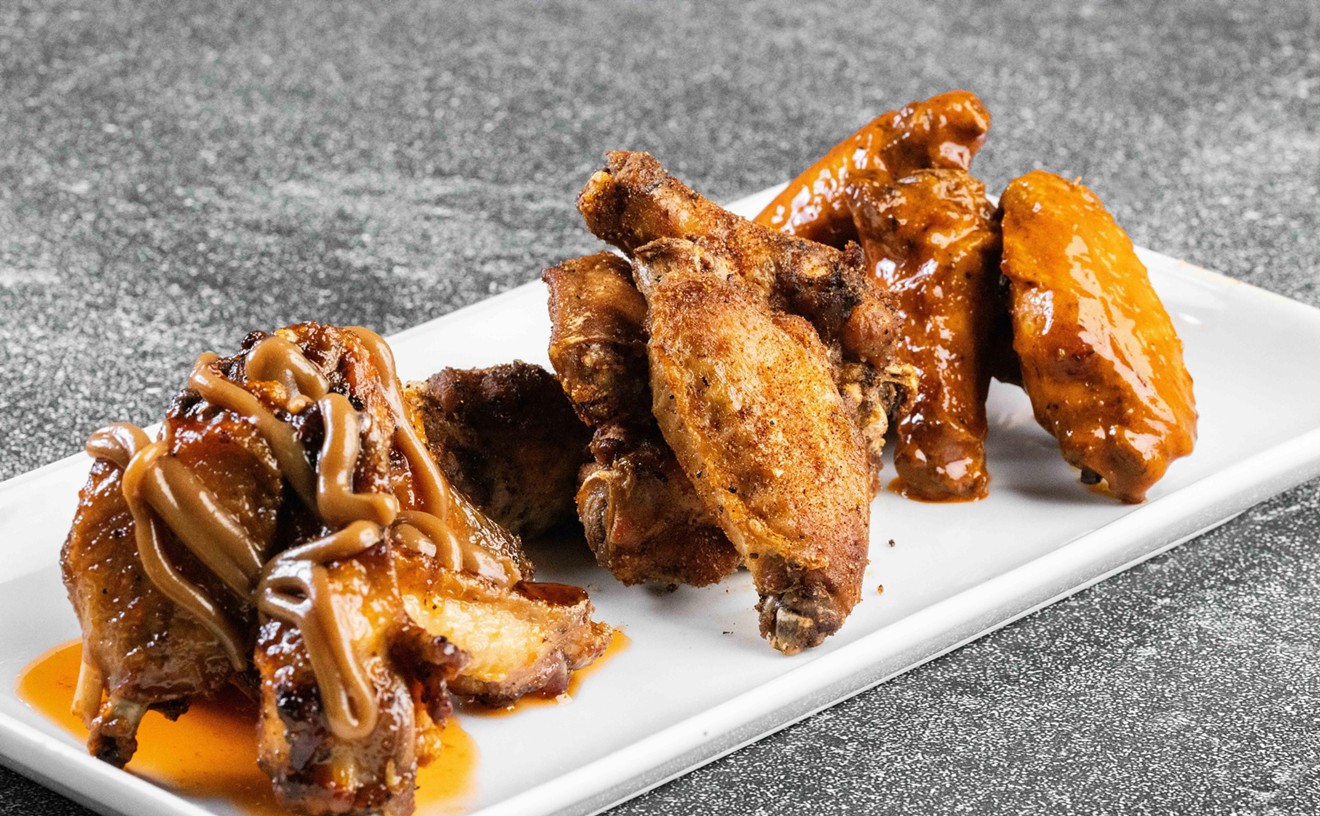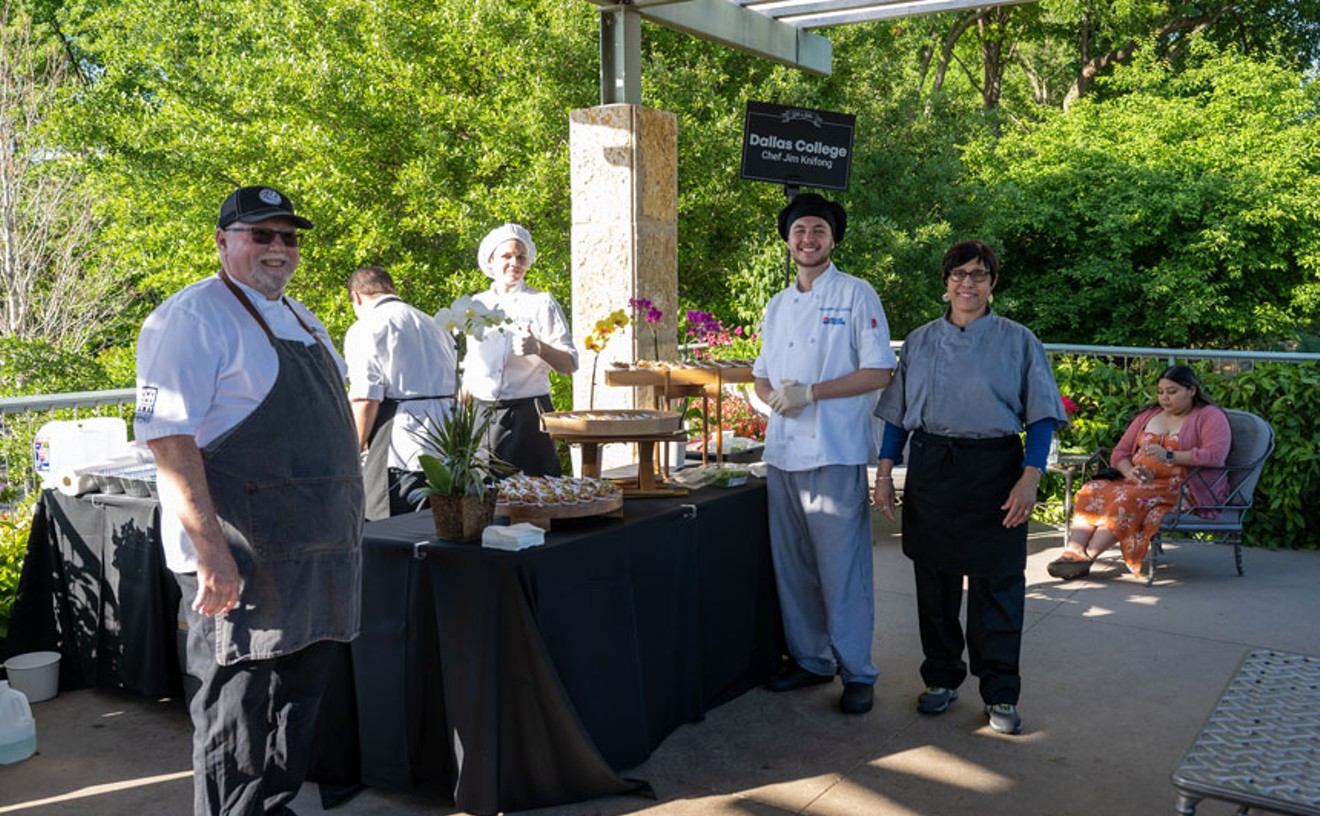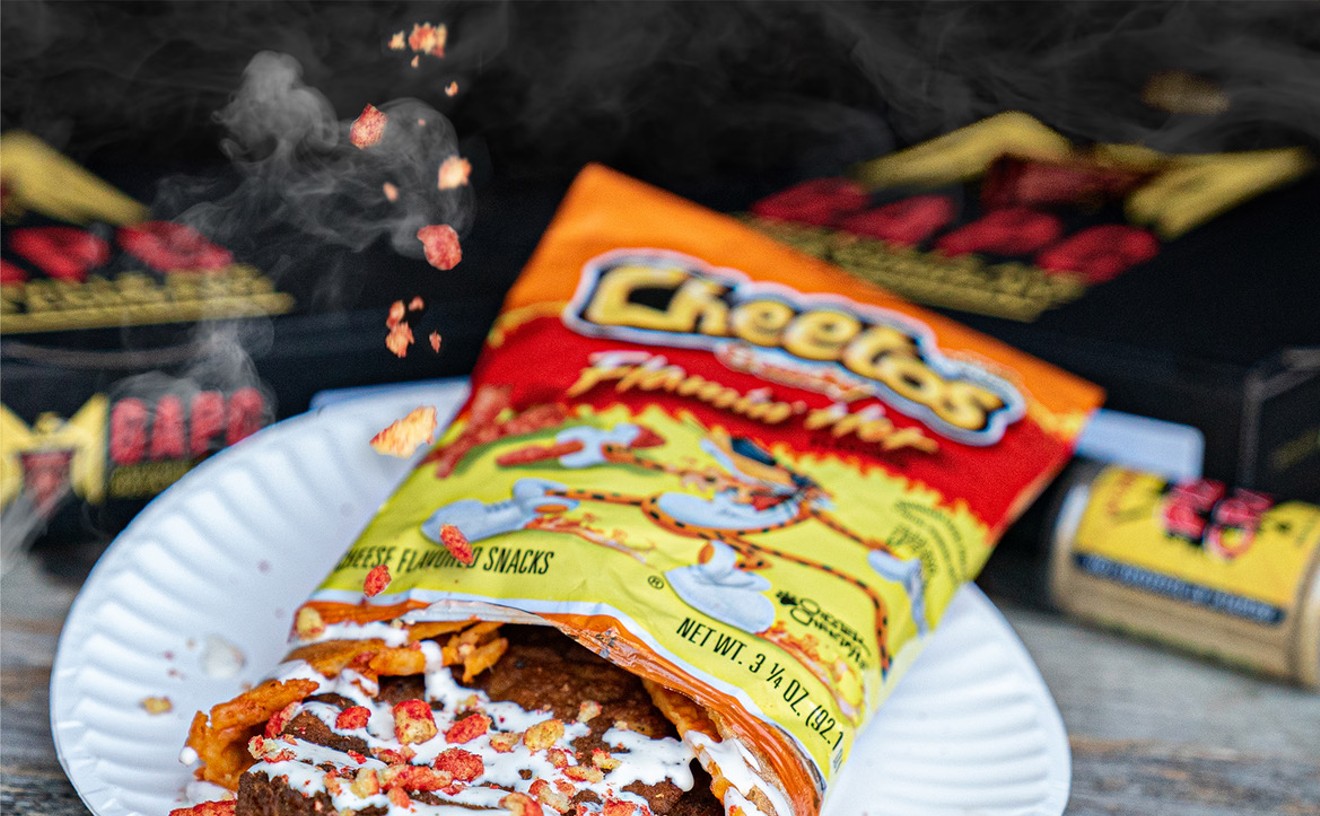“What do you want for dinner?”
“I don’t know. Maybe one of the foods enjoyed by 60 percent of the world’s population, but I can’t narrow it down more than that.”
“Cool. Let’s go to a restaurant that serves samplings of the cuisines that four billion people eat, and decide when we get there.”
I wonder if people in Asia have pan-everywhere-else restaurants. They could serve empanadas, tagine and clam chowder. After ordering from an extensive ceviche bar, dressy-casual customers would scoop up queso with injera and share a case of Foster’s.Pan-Asian restaurants ... persist because Dallas investors are unwilling to hand big dollars and downtown real estate deals to immigrant restaurateurs.
tweet this
Luckily America’s pan-Asian craze shone brightly in the Clinton administration and then died out, leaving only the faintest memory that, once upon a time, wasabi mashed potatoes were a thing. There wasn’t even time for anyone to ask why “pan-Asian” menus never included food from Muslim cultures.
Now, however, Dallas is seeing a comeback. This year, two new high-end restaurants opened in reductive celebration of half the world’s cuisines: Imoto (Japanese for “little sister”) and Musume (Japanese for “daughter”). Musume even serves wasabi mashed potatoes ($9).
Are they any good? Is the “pan-Asian” fad back? The answers: They’re acceptable, and dear lord, I hope not.
Musume: The Arts District’s second-best sushi bar
Described as “contemporary Asian fusion” in press materials, Musume’s spread of chashu pork, steamed buns and papaya salad could be fairly labeled pan-Asian. The focus is on Japan, however, with an extensive sake list and a whole menu page of sushi specials — which include some of the menu’s biggest disappointments.
Earlier this year Musume drew flak for a “Hot Mess” roll, which proved true to its name, a joke many diners thought was at their figurative (and literal) expense. Now I’m more concerned about the “White Dragon” roll, a promising-sounding combo of unagi and fish roe that comes wrapped in a slippery rice paper condom protecting us from the tastes and textures inside ($19).
I’ll let my dining companion describe the White Dragon roll: “I took to pushing the middle out of the rice paper with my tongue to get some flavor. It’s probably the weirdest sushi I’ve ever tasted. But it’s not terrible.”
Speaking of not terrible, the smoked tofu main course, with dainty portions of shiitake mushroom caps, lotus root and string-still-on peas on a squash puree, is enjoyably light, though in hindsight I realize we paid $18 for four bite-sized cubes of tofu. A special called “Dim Sum” was a set of five steamed seafood dumplings resembling shu mai, filled generously ($12). They’re very good and close to great — a few chives and a few extra seconds of steaming will do — although the trio of sauces, including mustard, are rather eccentric.
Two intensely flavored steamed buns round out a meal, which, for two people who drink only tap water, tops $80 (and that’s without the salad order our server confidently declined to write down, and immediately forgot). The bao — Musume serves pork belly and fried chicken; we grabbed one of each — are boldly sauced with both a hot pepper relish and a smear of mayo, and the crunch on the chicken is a delight ($14 for two). I wish one of the buns hadn’t ripped straight down the middle under the weight of fillings.
In a past era, or a city with little competition, Musume’s little flaws and quirks would be worth tolerating. But it’s not even the best sushi bar on its own street.
Imoto: Chef Kent Rathbun’s comeback is a throwback
Imoto (actual slogan: “Flavors of the East”) has a Japanese name, a sake list and a full sushi bar. Naturally, my favorite dish is Indian.
The restaurant’s atmosphere is relentlessly clubby: Patrons stepping inside the mirrored-glass doors immediately face a wide, techno-charged bar. Even when the restaurant is empty and seating is prompt, intrusive hosts demand customers’ full names and phone numbers.
For what it is, though, Imoto exceeds expectations. That’s especially true in the case of the token Indian dish, a clay pot of slow-cooked, falling-apart lamb flanked by assorted goodies: grilled naan slices, fresh green garbanzo beans, microgreens and cucumber raita ($22). The lamb, in a mildly spiced broth that would be welcomed across the Middle East, is wonderful, and assembling the ingredients is messy fun. (Our server describes the finished product as “tacos.” Bah, humbug.)
East Asian foods are less consistent. Good, fresh eel sushi ($7 for two pieces) is overshadowed by snapper sushi ($8 for two pieces), which arrives with a surprise layer of shiso leaves and a lemon marinade so pungent that the fish’s flavor is obliterated. A nicely cooked side order of seared Chinese broccoli is actually mostly American broccoli, along with unannounced water spinach and Brussels sprouts ($7).
I love the sauce, seemingly half gochujang and half butter, which comes with Imoto’s “Korean” fried chicken ($15), and I love the tenderness of the dark meat cuts. But the thin batter is nothing at all like the crisp, bubbly hallmark of a real Korean chicken restaurant, and contact with sauce turns the meat soggy.
There are warning signs on Imoto’s horizon: that “Flavors of the East” tagline, the nightclub vibe, the two servers who misidentified foods on our plates. But, for diners who feel adventurous inside a diorama version of Asian fare, Imoto mostly delivers the goods. It may reduce whole nations to token dishes, but at least many of them taste good.
Attack of the culinary mimics
Dallas left these restaurants behind before they even opened.
Since the 1990s heyday of pan-Asian food, the American dining scene has evolved in liberating ways. Non-Asian customers have learned to love foods other than pot stickers and California rolls. Asian-American chefs are finally gaining respect from investors and food writers, who are now, still too infrequently, Asian themselves. A new generation of culinary leaders is making menu descriptors like “dragon-style” look silly.
In Dallas, changes in demographics and culture render Musume and Imoto obsolete at birth. There are dozens of nearby vendors of sashimi, bao, naan, papaya salad and spring rolls, many of them outstanding. Our city and its suburbs are thrilling, vibrant markets for the cuisines of Japan, Korea, China, Vietnam, Laos, The Philippines, Pakistan, India, Sri Lanka, Nepal, Afghanistan and Iraq.
In a press release when the restaurant opened, Imoto partner Kent Rathbun said, “Everything about Imoto is geared to taking you to an exotic, cool locale.” Pardon me, chef, but that exotic, cool locale is just a few miles down the street.
At the start of this review, I joked that pan-Asian restaurants were invented by indecisive diners. That, of course, is fantasy. They persist because Dallas investors are unwilling to hand big dollars and downtown real estate deals to immigrant restaurateurs, but are perfectly happy to open their wallets for white-skinned, well-connected industry veterans who want to mimic “exotic, cool” foodways.
I don’t doubt the sincere fondness and enthusiasm the Imoto and Musume teams have for a half-dozen largely unrelated cuisines, developed thousands of miles apart, which just happen to share name recognition among the Texas public. I love all these foods too. But why treat them so superficially?
Everything Musume and Imoto can do, other Dallas-area restaurants can do better. That’s the bottom line. In its heyday, the pan-Asian food movement in America was doomed as a hodgepodge of second-class remakes at first-class prices. It’s doomed for the same reason now.
Imoto, 2400 Victory Park Lane. 214-257-7777, imotodallas.com. Open Monday through Thursday 4-11 p.m. and Friday and Saturday 4 p.m.-midnight.
Musume, 2330 Flora St. 214-871-8883, musumedallas.com. Open nightly 5:30-10:30 p.m. and Monday through Thursday 11 a.m.-2:30 p.m.

